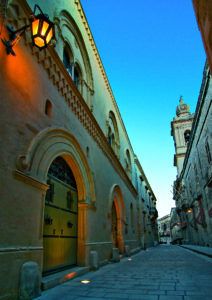Nowhere else on the island can make you breathe art and culture more satisfactorily than Palazzo Falson. With its elegant architecture and impressive collections this palace is a feast for the eyes and a balm for the soul.
The current structure of the Palazzo, a two storied structured around a central courtyard is one typical of medieval times. However, it originally started off as a series of rooms, found at the back of the courtyard, dating back to the 13th century. The latter were built on the remains of a structure called La Rocca and was associated with the Jewish community living in the city. Palazzo Falson was acquired by the Falsone Family, a family that held important administrative roles in Mdina, during the 16th century. The Falsones carried out further structural changes, many of them in preparation of visits from important guests such as Grand Master Philippe Villiers de L’Isle Adam who stayed briefly here in 1530 upon the Knight’s of St John’s arrival in Malta. The Falsones however lost the palace following Matteo Falsone’s dabbling with the Lutheran religion, back then a heinous sin against the Catholic Faith as regulated by the Roman Inquisition. Following this incident the palace passed on to various owners, all making their own changes and additions to the architectural fabric of the palace, until it was acquired by the late Olaf Frederick Gollcher who made it a point to buy the parts of the palace that by then had been given to different tenants. Following his passing away Fondazzjoni Patrmonju Malti entered into an agreement with the Captain O. F. Gollcher O.B.E Art & Archaeological Foundation with the aim of restoring and making accessible the house and it’s magnificent collections.

Palazzo Falson Facade
The Palace is not only a pleasure to visit for architecture enthusiasts but it also exhibits within its rooms veritable treasure troves, one that will make even the most hard to please visitor’s heart flutter a little. Collections exhibited, painstakingly built over the years by Gollcher and his predecessors, and spanning centuries, include: ship models, paintings, maps, Turkish rugs, fans, perfume bottles and costumes, furniture, kitchenware made from silver, majolica and pottery, religious icons and reliquaries, magnificent jewellery, watches, illuminated manuscripts, arms and armour, books, illuminated manuscripts and documents, coins and medals.
Interesting items from the above collection include:
A Victorian double ended scent bottle – The container itself, apart from the perfume, became a decorative item in itself. The double ended bottle contained perfume at one end and smelling salts in the other and was usually at hand when on an outing. Considering the tights corsets worn at the time, which plenty a fainting spell, these bottles came in very handy.
A Persian double-edged curved dagger – the dagger is similar to the traditional Jambiya (an object worn on the hip) in shape. Very common within the Islamic culture it was mainly used during hunting trips, fighting and ritual ceremonies. This dagger is decorated with the popular eight pointed star motif, a symbol of good fortune in many cultures.
A 1636 Illuminated manuscript showing an image of a Madonna and Child decorated in gold.
An 1886 Edward Lear watercolour and pen drawing entitled Fomm ir-Riħ.
What more do you need to interest you in an afternoon (or more!) spent exploring this palace in the heart of Malta’s old capital city? Accompanied by the sound of running water coming from the intricately sculpted stone fountain in the centre of the courtyard, together with medieval instrumental music playing softly this will be surely be one of the most pleasant afternoons you will have spent on the island.